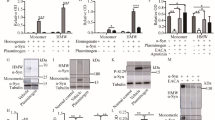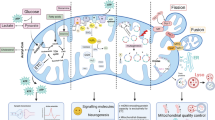Abstract
Asymmetric dimethylarginine (ADMA), an endogenous nitric oxide synthase (NOS) inhibitor, is profoundly protective against 1-methy-4-phenylpyridinium ion (MPP+)-induced neurotoxicity. Reactive oxygen species (ROS) overproduction contributes to the neurotoxicity of MPP+; while hydrogen sulfide (H2S) is a pivotal endogenous antioxidant. This study is to assess the potential role of endogenous H2S in the neuroprotection of ADMA against MPP+-induced toxicity in PC12 cells. We showed that ADMA prevented MPP+-induced inhibition of endogenous H2S generation through inhibiting the down-regulation of cystathionine-β-synthetase (CBS, the major enzyme responsible for endogenous H2S generation in PC12 cells) expression and activity elicited by MPP+. ADMA obviously attenuated MPP+-triggered accumulation of intracellular ROS, dissipation of mitochondrial membrane potential (MMP), release of cytochrome c (Cyt-c), and downregulation of Bcl-2 protein expression in PC12 cells. Inhibition of CBS activity by amino-oxyacetate and CBS silencing with a short hairpin RNA vector targeting rat CBS gene reversed the protective action of ADMA against MPP+-caused cytotoxicity, ROS overproduction, and MMP loss in PC12 cells. These results indicate that the protection of ADMA against MPP+-mediated neurotoxicity involves the melioration of MPP+-induced inhibition of endogenous H2S generation. Our findings suggest that modulation of H2S production provide new therapeutic targets for the treatment of neurodegenerative disease, such as Parkinson’s disease.







Similar content being viewed by others
References
Dawson TM, Dawson VL (2002) Neuroprotective and neurorestorative strategies for Parkinson’s disease. Nat Neurosci 5(Suppl):1058–1061
Vila M, Przedborski S (2003) Targeting programmed cell death in neurodegenerative diseases. Nat Rev Neurosci 4:365–375
Langston JW, Ballard P, Tetrud JW, Irwin I (1983) Chronic Parkinsonism in humans due to a product of meperidine-analog synthesis. Science 219:979–980
Przedborski S, Tieu K, Perier C, Vila M (2004) MPTP as a mitochondrial neurotoxic model of Parkinson’s disease. J Bioenerg Biomembr 36:375–379
Schapira AH, Cooper JM, Dexter D, Jenner P, Clark JB et al (1989) Mitochondrial complex I deficiency in Parkinson’s disease. Lancet 1:1269
Vallance P, Leone A, Calver A, Collier J, Moncada S (1992) Accumulation of an endogenous inhibitor of nitric oxide synthesis in chronic renal failure. Lancet 339:572–575
Tang XQ, Li YJ, Zhao J, Shen XT, Yang CT et al (2010) Neuroprotective effect of asymmetric dimethylarginine against 1-methyl-4-phenylpyridinium ion-induced damage in PC12 cells. Clin Exp Pharmacol Physiol 37:530–535
Kimura H (2002) Hydrogen sulfide as a neuromodulator. Mol Neurobiol 26:13–19
Wang R (2002) Two’s company, three’s a crowd: can H2S be the third endogenous gaseous transmitter? FASEB J 16:1792–1798
Lowicka E, Beltowski J (2007) Hydrogen sulfide (H2S)—the third gas of interest for pharmacologists. Pharmacol Rep 59:4–24
Szabo C (2007) Hydrogen sulphide and its therapeutic potential. Nat Rev Drug Discov 6:917–935
Zhang LM, Jiang CX, Liu DW (2009) Hydrogen sulfide attenuates neuronal injury induced by vascular dementia via inhibiting apoptosis in rats. Neurochem Res 34:1984–1992
Tan BH, Wong PT, Bian JS (2010) Hydrogen sulfide: a novel signaling molecule in the central nervous system. Neurochem Int 56:3–10
Qu K, Lee SW, Bian JS, Low CM, Wong PT (2008) Hydrogen sulfide: neurochemistry and neurobiology. Neurochem Int 52:155–165
Kimura Y, Kimura H (2004) Hydrogen sulfide protects neurons from oxidative stress. Faseb J 18:1165–1167
Whiteman M, Armstrong JS, Chu SH, Jia-Ling S, Wong BS et al (2004) The novel neuromodulator hydrogen sulfide: an endogenous peroxynitrite ‘scavenger’? J Neurochem 90:765–768
Whiteman M, Cheung NS, Zhu YZ, Chu SH, Siau JL et al (2005) Hydrogen sulphide: a novel inhibitor of hypochlorous acid-mediated oxidative damage in the brain? Biochem Biophys Res Commun 326:794–798
Tang XQ, Yang CT, Chen J, Yin WL, Tian SW et al (2008) Effect of hydrogen sulphide on beta-amyloid-induced damage in PC12 cells. Clin Exp Pharmacol Physiol 35:180–186
Tang XQ, Fan LL, Li YJ, Shen XT, Zhuan YY et al (2011) Inhibition of hydrogen sulfide generation contributes to 1-methy-4-phenylpyridinium ion-induced neurotoxicity. Neurotox Res 19:403–411
Yin WL, He JQ, Hu B, Jiang ZS, Tang XQ (2009) Hydrogen sulfide inhibits MPP(+)-induced apoptosis in PC12 cells. Life Sci 85:269–275
Li R, Kong Y, Ladisch S (1998) Nerve growth factor-induced neurite formation in PC12 cells is independent of endogenous cellular gangliosides. Glycobiology 8:597–603
Wang S, Hu CP, Jiang DJ, Peng J, Zhou Z et al (2009) All-trans retinoic acid inhibits cobalt chloride-induced apoptosis in PC12 cells: role of the dimethylarginine dimethylaminohydrolase/asymmetric dimethylarginine pathway. J Neurosci Res 87:1938–1946
Duan WG, Shang J, Jiang ZZ, Yao JC, Yun Y et al (2009) Rho kinase inhibitor Y-27632 down-regulates norepinephrine synthesis and release in PC12 cells. Basic Clin Pharmacol Toxicol 104:434–440
Cathcart R, Schwiers E, Ames BN (1983) Detection of picomole levels of hydroperoxides using a fluorescent dichlorofluorescein assay. Anal Biochem 134:111–116
Grieve A, Butcher SP, Griffiths R (1992) Synaptosomal plasma membrane transport of excitatory sulphur amino acid transmitter candidates: kinetic characterisation and analysis of carrier specificity. J Neurosci Res 32:60–68
Johnson LV, Walsh ML, Bockus BJ, Chen LB (1981) Monitoring of relative mitochondrial membrane potential in living cells by fluorescence microscopy. J Cell Biol 88:526–535
Blum D, Torch S, Lambeng N, Nissou M, Benabid AL et al (2001) Molecular pathways involved in the neurotoxicity of 6-OHDA, dopamine and MPTP: contribution to the apoptotic theory in Parkinson’s disease. Prog Neurobiol 65:135–172
Kluck RM, Bossy-Wetzel E, Green DR, Newmeyer DD (1997) The release of cytochrome c from mitochondria: a primary site for Bcl-2 regulation of apoptosis. Science 275:1132–1136
Yang J, Liu X, Bhalla K, Kim CN, Ibrado AM et al (1997) Prevention of apoptosis by Bcl-2: release of cytochrome c from mitochondria blocked. Science 275:1129–1132
Kowaltowski AJ, Vercesi AE, Fiskum G (2000) Bcl-2 prevents mitochondrial permeability transition and cytochrome c release via maintenance of reduced pyridine nucleotides. Cell Death Differ 7:903–910
Drechsel DA, Patel M (2008) Role of reactive oxygen species in the neurotoxicity of environmental agents implicated in Parkinson’s disease. Free Radic Biol Med 44:1873–1886
Abou-Sleiman PM, Muqit MM, Wood NW (2006) Expanding insights of mitochondrial dysfunction in Parkinson’s disease. Nat Rev Neurosci 7:207–219
Orrenius S (2007) Reactive oxygen species in mitochondria-mediated cell death. Drug Metab Rev 39:443–455
Hildeman DA, Mitchell T, Aronow B, Wojciechowski S, Kappler J et al (2003) Control of Bcl-2 expression by reactive oxygen species. Proc Natl Acad Sci U S A 100:15035–15040
Moungjaroen J, Nimmannit U, Callery PS, Wang L, Azad N et al (2006) Reactive oxygen species mediate caspase activation and apoptosis induced by lipoic acid in human lung epithelial cancer cells through Bcl-2 down-regulation. J Pharmacol Exp Ther 319:1062–1069
Nicholls DG, Budd SL (2000) Mitochondria and neuronal survival. Physiol Rev 80:315–360
Brunelle JK, Letai A (2009) Control of mitochondrial apoptosis by the Bcl-2 family. J Cell Sci 122:437–441
Nakao A, Sugimoto R, Billiar TR, McCurry KR (2009) Therapeutic antioxidant medical gas. J Clin Biochem Nutr 44:1–13
Chang L, Geng B, Yu F, Zhao J, Jiang H et al (2008) Hydrogen sulfide inhibits myocardial injury induced by homocysteine in rats. Amino Acids 34:573–585
Yan SK, Chang T, Wang H, Wu L, Wang R et al (2006) Effects of hydrogen sulfide on homocysteine-induced oxidative stress in vascular smooth muscle cells. Biochem Biophys Res Commun 351:485–491
Tang XQ, Shen XT, Huang YE, Ren YK, Chen RQ et al (2010) Hydrogen sulfide antagonizes homocysteine-induced neurotoxicity in PC12 cells. Neurosci Res 68:241–249
Whiteman M, Winyard PG (2011) Hydrogen sulfide and inflammation: the good, the bad, the ugly and the promising. Expert Rev Clin Pharmacol 4:13–32
Acknowledgments
This study was supported by Natural Science Foundation of China (81071005, 30770740), Natural Science Foundation of Hunan Province, China (06JJ2074).
Author information
Authors and Affiliations
Corresponding authors
Rights and permissions
About this article
Cite this article
Tang, XQ., Fang, HR., Li, YJ. et al. Endogenous Hydrogen Sulfide is Involved in Asymmetric Dimethylarginine-induced Protection Against Neurotoxicity of 1-Methyl-4-phenyl-pyridinium Ion. Neurochem Res 36, 2176–2185 (2011). https://doi.org/10.1007/s11064-011-0542-y
Accepted:
Published:
Issue Date:
DOI: https://doi.org/10.1007/s11064-011-0542-y




